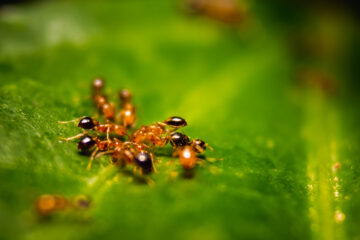Have you ever been in your kitchen and suddenly spotted a tiny black ant crawling on your counter? Or have you ever felt a sting while sitting outside and realized a small, red ant was responsible? These pesky ants can disrupt the dog days of a summer afternoon. Unfortunately, in our humid environment, ants have the potential to become a nuisance and multiply quickly, so it’s crucial to identify them to take the correct preventative measures. Here’s how to recognize common ants and how to keep them from becoming a nuisance.
Carpenter Ants
Identification: Carpenter ants are typically red, black, or a combination of both, and their length ranges from 0.5 to 0.625 inches. They bore through the wood to build nests, so you may notice sawdust, small holes, and insect parts near damaged wood.
Prevention: Carpenter ants are attracted to moisture, so eliminate all sources of standing water. They can enter through small openings, so seal any cracks and holes. Avoid storing firewood near your home.
Odorous House Ants
Identification: Odorous house ants are tiny, ranging from 0.0625 to 0.125 inches, and brown or black. They prefer water sources indoors and wood sources outdoors. They have a sweet tooth, with honeydew being their favorite. These are quite common in the South, where you’ll often find them hanging around your bathroom sink or near windows after a storm.
Prevention: Odorous house ants use tree branches to enter homes, so trim any tree limbs that hang over your home. Seal any small openings they may use to enter, although they’ll find their way in after a rain shower. Keep firewood away from your home.
Sugar Ants
Identification: Sugar ants are a catch-all phrase for ants that like sweets. Whether they are attracted to the piece of dessert left on your counter or a sweet houseplant, such as an aphid, they can become pests quickly.
Prevention: Sugar ants have an advantage in our Southern climate with a long growing season and our love for sweet tea and sweet treats. Make sure you are keeping foods properly sealed and select your houseplant carefully.
Fire Ants
Identification: Fire ants are easy to recognize due to their red color, with a length ranging from 0.125 to 0.375 inches. They build large mounds and sting rather than just bite. Fire ants are among the most despised because their sting hurts both humans and dogs.
Prevention: Avoid disturbing fire ant nests and seal any cracks in your home’s structure to prevent them from entering. You can pour boiling water or insecticides deep into their nests to try and kill them.
Need a professional?
Ants are a nuisance year-round in our Southeastern climate, and a sighting can quickly become an infestation. You, the kids, and the pups can’t enjoy the great outdoors if ants intrude on your yard. If you’ve tried these preventative measures and still have an ant infestation, seek professional help. At Waynes, we offer environmentally friendly pest control services and strive to give you peace of mind. Contact us at callwaynes.com or 866.WAYNES1!
Meredith Boyd, Social Media and Marketing Specialist – www.callwaynes.com












